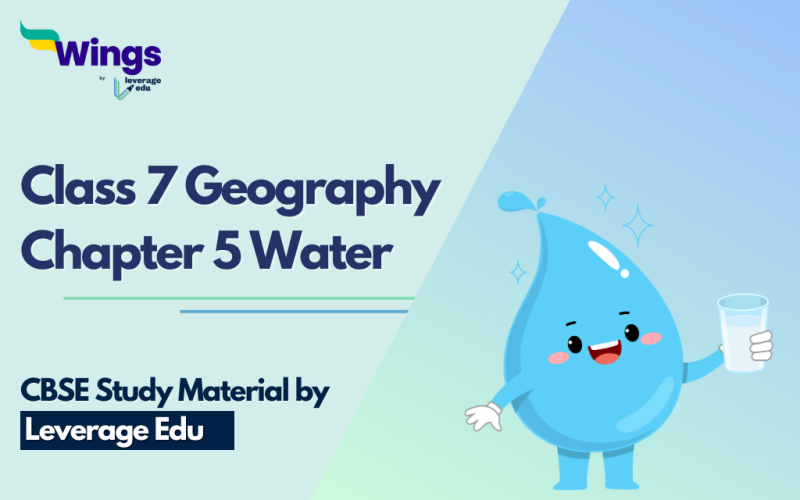NCERT Class 7 Geography Chapter 5 Water talks about the significance of water as a crucial natural resource. It covers various aspects of water, from its distribution on Earth to its forms – liquid, solid, and gas. The chapter emphasises the importance of conserving water and highlights the challenges faced in its fair distribution. It also introduces students to concepts like precipitation, evaporation, condensation, and the water cycle, helping them grasp the interconnectedness of Earth’s water systems. The chapter also discusses the role of rivers, lakes, and oceans in supporting life. It encourages an understanding of water-related issues, such as scarcity and pollution, and proposes sustainable solutions.
Download Social Science Class 7 Geography Chapter 5 Important Questions and Answers PDF
Explore all the Chapters of Class 7 Geography:-
📌Also Read: NCERT Class 7 Geography: Chapter 1 Environment (Free PDF)
Important Definitions in NCERT Class 7 Geography Chapter 5
- Terrarium: It is an artificial enclosure for keeping small house plants.
- Water Cycle: The process by which water continually changes its form and circulates between oceans, atmosphere and land is known as the water cycle.
- Waves: When the water on the surface of the ocean rises and falls alternately, they are called waves.
- Tides: The rhythmic rise and fall of ocean water twice daily is called a tide.
- Ocean currents: Ocean currents are streams of water flowing constantly on the ocean surface in definite directions.
📌Also Read: NCERT Class 7 Geography: Chapter 2 Inside Our Earth (Free PDF)
Download Social Science Class 7 Geography Chapter 5 Important Questions and Answers PDF
Explore all the Chapters of Class 7 Geography:-
Important Questions in NCERT Class 7 Chapter 5: Free PDF Download
1. Answer the following questions.
(i) What is precipitation?
Ans. The sun’s heat vaporises water into vapour. This vapour cools down and condenses to become clouds. This may then fall on the surface of Earth in the form of rain, snow or sleet. This phenomenon of water falling back onto the earth’s surface in the form of rain, snow or sleet is called precipitation.
(ii) What is the water cycle?
Ans. The process by which water continually changes its form and circulates between oceans, atmosphere and land is known as the water cycle.
(iii) What are the factors affecting the height of the waves?
Ans. The factors affecting the height of the waves are as mentioned:
- Speed of the wind
- Earthquakes, volcanic eruptions or underwater landslides
(iv) Which factors affect the movement of ocean water?
Ans: The factors affecting the movement of ocean water are as mentioned:
- Temperature
- Gravitational pull of the sun and moon
- Warm and cold currents
- Wind
(v) What are tides and how are they caused?
Ans: The rhythmic rise and fall of ocean water twice daily is called a tide. It is high tide when water covers much of the shore by rising to its highest level. It is low tide when water falls to its lowest level and recede from the shore. The strong gravitational pull exerted by the sun and the moon on the earth’s surface causes the tides.
(vi) What are ocean currents?
Ans: Ocean currents are streams of water flowing constantly on the ocean surface in definite directions. The ocean currents may be warm or cold.
📌Also Read: NCERT Class 7 Geography: Chapter 3 Our Changing Earth (Free PDF)
2. Give reasons.
(i) Ocean water is salty.
Ans: Ocean water is salty because it contains a large amount of salt dissolved in it. The salt present in ocean water is mostly sodium chloride or the common salt that we consume.
(ii) The quality of water is deteriorating.
Ans: The water quality is deteriorating because of activities like deforestation, throwing garbage, chemical waste in water bodies and increased use of fertilisers and pesticides.
3. Tick the correct answer.
(i) The process by which water continually changes its form and circulates between oceans, atmosphere and land
(a) Water cycle
(b) Tides
(c) Ocean currents
Ans: a
(ii) Generally, the warm ocean currents originate near
(a) Poles
(b) Equator
(c) None of these
Ans: b
(iii) The rhythmic rise and fall of ocean water twice in a day is called
(a) Tide
(b) Ocean current
(c) Wave
Ans: a
4. Match the following.
| (i) Caspian Sea | (a) Largest lake |
| (ii) Tide | (b) Periodic rise and fall of water |
| (iii) Tsunami | (c) Strong seismic waves |
| (iv) Ocean currents | (d) Streams of water moving along definite paths |
| (e) Water cycle |
Ans:
| (i) Caspian Sea | (a) Largest lake |
| (ii) Tide | (b) Periodic rise and fall of water |
| (iii) Tsunami | (c) Strong seismic waves |
| (iv) Ocean currents | (d) Streams of water moving along definite paths |
Explore Notes of All subjects of CBSE Class 7:-
| CBSE NCERT Notes Class 7 English | CBSE NCERT Notes Class 7 History | CBSE NCERT Notes Class 7 Geography |
| CBSE NCERT Notes Class 7 Civics | CBSE NCERT Notes Class 7 Mathematics | CBSE NCERT Notes Class 7 Science |
Check out Class 6 Geography Notes:
FAQs
Ans: The sun’s heat vaporizes water into vapor. This vapor cools down and condenses to become clouds. This may then fall on the surface of Earth in the form of rain, snow or sleet. This phenomenon of water falling back onto the earth’s surface in the form of rain, snow or sleet is called precipitation.
Ans: The process by which water continually changes its form and circulates between oceans, atmosphere, and land is known as the water cycle.
Ans: Ocean currents are streams of water flowing constantly on the ocean surface in definite directions.
Follow Leverage Edu for complete study material on CBSE Notes of Class 7 Geography
 One app for all your study abroad needs
One app for all your study abroad needs













